| ID | #1560261136 |
| Added | Tue, 11/06/2019 |
| Author | July N. |
| Sources | |
| Phenomena | |
| Status | Result
|
| Resume |
Initial data
On Tuesday, 3 June 2014, about noon, was found the corpse of a strange sea mammal. He was discovered on the beach in Bidart, located in the Department of Pyrenees-Atlantic, in the extreme South-West of France.
That day the pedestrians come face to face with the creature, the origin of which seems very mysterious. Shortly after this discovery the author Alex Picone quickly put it in your profile in Facebook, accompanying the following comment:
"What can we find on our beaches while walking ... (today and 13H). The remains of a sperm whale? "
Translated by «Yandex.Translator»
Original news
Mardi midi, ce qu’il reste d’un mammifère marin s’est échoué sur une plage de Bidart suscitant le questionnement dans le village et sur les réseaux sociaux
Des promeneurs ont fait une étonnante découverte, ce mardi midi, à Bidart. Ils sont tombés nez à nez avec cette créature difficilement identifiable. Pris en photo et publié sur Facebook, ce qui semble être le reste d’un mammifère marin est l’objet de questionnements.
"Ce qu’on peut trouver sur nos plages en se promenant … (aujourd’hui 13h). Un reste de cachalot ?", demande Alex Pekone auteur de la photo, sur son profil Facebook.
______________________________
Le mardi 3 juin 2014, aux alentours de midi, le cadavre d’un étrange mammifère marin a été découvert sur une plage de la ville de Bidart, située dans le département des Pyrénées-Atlantiques, à l’extrême Sud-Ouest de la France.
Ce jour-là des promeneurs sont tombés nez à nez avec une créature dont l’origine paraît bien mystérieuse. Peu après cette trouvaille, l’auteur de la photographie, Alex Pekone, s’est empressé de la poster sur son profil Facebook, accompagnée du commentaire suivant :
« Ce qu'on peut trouver sur nos plages en se promenant ... (aujourd'hui 13h). Un reste de cachalot ? »
Une explication ?
Peu après sa publication, le cliché a suscité une immense controverse parmi les internautes, incitant la directrice du Musée de la Mer, Françoise Pautrizel, de faire la lumière sur cette énigme. Pour cette océanographe, il n’y a aucun doute, il s’agit d’une espèce de globicéphale noir. Elle explique :
« C'est un cétacé à dents de la famille des dauphins, je l'ai reconnu à la forme de sa tête, arrondie, qui le caractérise. »
Pour cette dernière, l’animal serait mort, au large, il y a plusieurs semaines déjà. C’est la raison pour laquelle il aurait perdu sa couleur noire. La créature aurait ensuite été en partie dévorée par ses congénères avant de s’échouer sur la plage.
Hypotheses
Famous creatures

There are a huge number of different living organisms on our planet. According to recent estimates, the number of species of organisms on our planet is approximately 7-10 million. However, only 15% of the data are described today.
According to the calculations of Canadians, 2.2 million species live in the world's oceans, 6.5 million on land. There are only about 7.8 million species of animals on the planet, 611 thousand fungi, and 300 thousand plants.
Post-mortem changes

Because ordinary people are rarely familiar with the nuances of postmortem changes in organisms, it can often take them for something mystical.
Gray meat flies eat rotting tissue, leaving a sharp edge. This explains the "surgical" removal of organs and parts of the skin. However, such behaviors of the flies many take for the interference of aliens or attacked by unknown creatures.
The main signs of this injury:
Investigation
Shortly after the publication of the picture the Director of the Museum of the sea françoise Pautrizel shed light on this mystery. For the oceanographer, there is no doubt that it's Keith. She explains:
"This is a toothed cetacean family of dolphins, I learned it in the form of a rounded head, which it characterizes."
Animal for several weeks dead. That's why he lost his black color. Also being partially devoured by their kinsmen, before he got stranded on the beach.
Translated by «Yandex.Translator»
Resume
Post-mortem changes

Because ordinary people are rarely familiar with the nuances of postmortem changes in organisms, it can often take them for something mystical.
Gray meat flies eat rotting tissue, leaving a sharp edge. This explains the "surgical" removal of organs and parts of the skin. However, such behaviors of the flies many take for the interference of aliens or attacked by unknown creatures.
The main signs of this injury:
Similar facts
Log in or register to post comments







